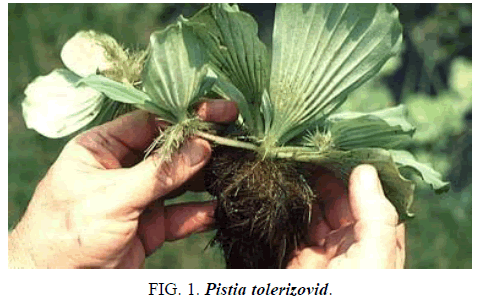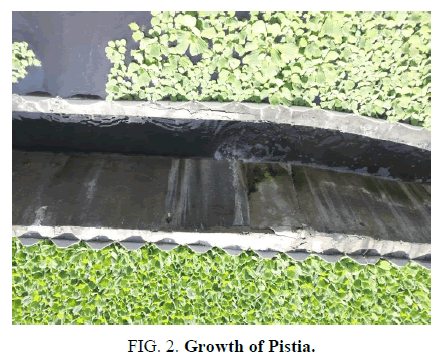Research
, Volume: 14( 6)Natural Distribution of Pistia Algae Plant and its Systematic Place and Biological Features
- *Correspondence:
- Cholpanoy Kuchkarova , Andijan Machine Building Institute, Republic of Uzbekistan, Andijan, Uzbekistan, E-Mail: Cholpanoy89@mail.ru
Received: November 15, 2018; Accepted: November 28, 2018; Published: December 27, 2018
Citation: Cholpanoy K. Natural Distribution of Pistius Algae Plant and its Systematic Place and Biological Features. Biotechnol Ind J. 2018;14(6):179.
Abstract
This article represents the materials of household purification methods. Waste water can be cleaned with the help of for example a plant pistil, highlights effective methods of household purification by analyzing the physical properties and chemical composition of the plant pistil in laboratory conditions. With the development of production, the amount of waste and sewage water leaving the plant increases.
Keywords
Furrow; Algae pest plants; Azolla; Biological purification; Domestic runoff; Eichornia
Introduction
Pistia belonging to the family of water cabbage and street flowers (Pistia stratiotes L) is a perennial aquatic plant that melts on the surface of the water and forms a watery vineyard. Pistia is considered the oldest plant. Its remains are found in the south of France and in North America. Currently, the range of Pistias is gaining in Asia, Africa, Australia and Europe [1,2]. Pisti fruit is dry, in the form of a single-celled box and has several seeds. The crust of the fruit bastard is thick and green. The crust of the ripe fruit bread-catcher thins and picks up a light brown color. As a result of the ripening of the fruit, the fruit cradle burst, and the seeds come out of the cradle. Some of them enter the lower part of the water, and some are glued to the roots of the gun. Fully matured semeni is brown in color, and not matured semeni are green in color. Semeni is long-cylindrical in shape and the fineness is 1.5 mm-3.0 mm. The mass of 1000 pieces of seeds is 2.2 g. The quiet period of Pistia seeds under conditions of introduction is very short under natural conditions. In the convenient conditions (water temperature is 25-26°C and it is necessary for a sufficient amount of light) the seeds start to grow after 14 days out of the seed bag. With the growth of pisti seeds, the decisive factor is considered to be light, because although with sufficient temperature, the seeds will not grow in a dark place. Pistia seeds are also resistant to long-term (up to 60 days) cold temperatures (3-5°C), continue to grow after 14-16 days. Under laboratory conditions (distilled water, temperature 26-28°C and especially light is needed) seed yield was found to be 72%. In the botanical gardens, Pistia is sown as ornamental and an aquarium. In addition, Pistia biomass is used as food for pigs [1-3]. Manure of various animals (ram, cow, pig, horse), sewage water of flax processing plants, enterprises producing mineral fertilizers, biochemical plants, alkali factories, meat producing factories, urban public services enterprises are good for the cultivation of pistia’s [4]. According to scientists, the growth of algae plants depends not only on the composition of the food environment and the type of plants but also on the density of seedlings planted. The density of the primary sowing planted on the surface is 1 m2 of water, depending on the food environment and the concentration of sewage water, 1 kg-3 kg, in some cases 5 kg/m of wet biomass. Pistia is well grown in the sewage waters of pork complexes and poultry farms. Its yield per day for 1m2 of the water surface is up to 1,400 grams of wet biomass [5] Below is a view of the algae plant Pistia telerizovid (FIG. 1).
In the conditions of Uzbekistan, the methods of growing Pistia plant are given in the works of RSH. Shoyakubova [4]. In our country, as an ornamental plant, it grows in the Botanical Gardens and from the amateur ribolov in aquariums. Pistia algae plants in winter conditions can be grown in greenhouses in the glass, plastic vessels and in aquariums, concrete reservoirs, and in summer conditions in ferroconcrete trays and cemented reservoirs in the open air. When the pistol is increased in the laboratory and in the open air, the growth of its individual fully grown parts is 20 cm-40 cm. The root system consists of shaggy, long, browed, small roots. The root is pale, transparent light, 0.5 m-0.6 m and maybe longer from it. The body is short and the leaves have a triangular shape. The upper part of the leaves is velvety green, and the lower part of silver-green consists of 9 to 12 pieces of the prominent vessel. Due to the porosity of the structure of the leaves, they are filled with air and the pistol grows on the surface of the water.
Pistia can bloom in the open air from the second half of April to November, and in greenhouse conditions throughout the year. Pistia has a feature of rapid reproduction through vegetation as well as from seeds. Vegetative reproduction mainly occurs through the process (stolon) of leaves that grow from the plant. New pistia’s are developed on the final processes. This circumstance continues throughout the summer and until late autumn can be repeated several times.
With the arrival of a comfortable climate in the seating arrangement, the pistols are transferred to the discovery of reservoirs. By the end of April and during the month of May, the Pistia is rapidly developing from the point of development, looking at the center in a circular shape, organs of multiplication are formed. During vegetation, up to 4-5 circles can form on each plant. Thus, the formation of leaves occurs from the center to the outer side, and the formation of the organs of reproduction, flowering, and ripening of seeds occurs from the outer side to the center.
The method of multiplication of the seed piston has several advantages as compared to the method of multiplication through vegetation. In the autumn-winter period, it is possible to grow sufficient seedlings for sowing in spring in the not very large vessels. To prepare the seeds for the pistia, in the months from September to October, vibrating the picty’s undergrowth over some material can be collected. The collected picty’s seeds are placed in a glass jar and filled with tap water or, if possible, distilled water. Tanks should not be large and not deep and for lighting, fluorescent lamps were used. With a decrease in temperature, the yield of seeds decreases. Pista emerging from the seeds should be illuminated within 7-8 hours. In this case, you can use the day lamp. After the appearance of a few roots at the exit of the Pistia comes to the surface of the water. They are not only from the endosperm but are transferred to a sovereign formation and therefore, it is necessary to replace distilled or tap water with sewage. Thus, young seedlings in early spring, with warming days, do not leave seeds in greenhouse conditions in small reservoirs built in the open air for Kriba and after preparing in sufficient quantity of seedlings, in April and May, sow livestock farms or industrial plants in biological reservoirs [6,7]. For use in a large number of plants Pistia in the conditions of Uzbekistan is of great importance to study flowering seeds. Mass flowering begins in 45-55 days from the flowering of the initial seating and lasts 60-65 days. With the growth of the pistols, the formations of 2 types of seeding were determined, that is, colorless and colored seed color. Both types of color are defined as seed flowers.
Conclusion
In conclusion, it can be said that in recent years, municipal and industrial enterprises have been increasing in the republic, they are developing and they are working intensively. With the development of production, the amount of waste and sewage water leaving the plant increases. Biological purification of sewage water leaving municipal and industrial enterprises, that is, accelerated biotechnology of purification through the use of various algae plants and high aquatic plants is considered one of the advantages of biological discipline. Given this, it is necessary to prevent the outflow of blue-green aquatic plants from under water, to develop measures of protection against anthropogenic influences. Because, with the help of hydrobionts living in biological reservoirs, which they develop in their vital activity special chemical things (antibiotics), as a result of which pathogenic bacteria spreading waterborne diseases are destroyed.
The purpose of our research work in the purification of municipal sewage waters of the city of Andijan is to increase the high (surface) water plant of the piston in laboratory conditions and to develop a biotechnology for the purification of urban municipal sewage water from various organic-mineral substances.
Conflicts of Interest
The authors declare no conflicts of interest.
References
- Muzaffrov MA. Flora of algae ponds of Central Asia. Science. 1965:117.
- Gillet W. Microbiology of tropical soils and the rand of productivity. Martinus Nijhoff/Dr W. Junk Publishers. 1982:169-85.
- Zhdanov AD, Cirilng D. Aquarium and aquatic plants. St. Pemterburg, Gidromemoizdat. 1991:1886-88.
- Shoyakubov RSH. Biology of pistis teleorisoid and the possibility of its practical use: Tashkent. 1993.
- Shoyakubov RSH. Sorceress Pistia Russia. Nature and Man. 1987:55.
- Eishman GI, Litfak AA. Water supply and wastewater treatment of chemical fiber enterprises. 1971:154.
- Ergashev AE. Economic efficiency of the biological method of sewage treatment using algae. Tashkent. 1998:123-24.



